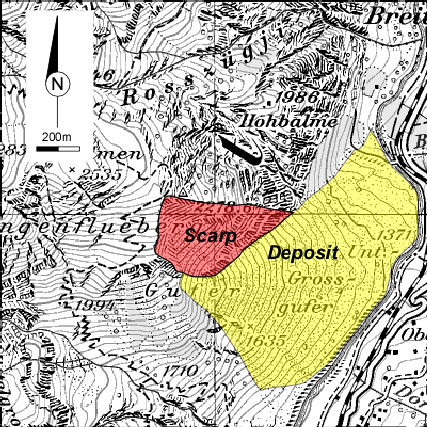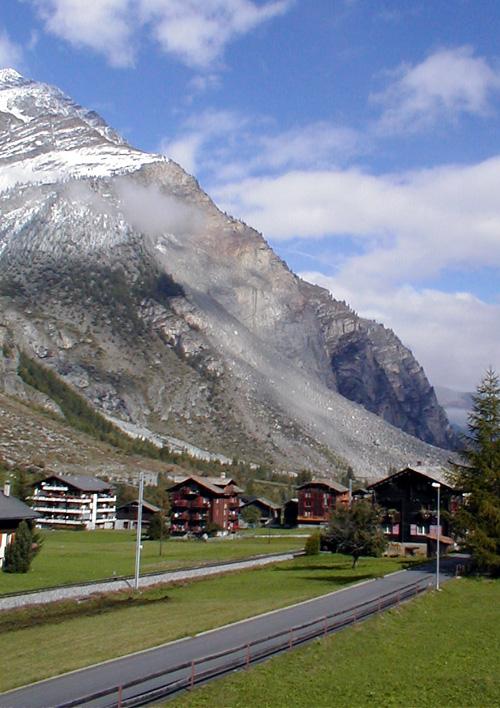Randa

Fig. 1: Randa rockfall geographic situation (topographic background from Swiss map 50).
About 30 million cubic meters of rocks fell from a rock face near the village of Randa (10 km north of Zermatt) in two main stages: the first one on April 18, 1991, and the second one on Mai 9, 1991. No fatalities were reported except for a few horses, cows and sheep. 31 chalets were buried. Both events caused the deposit of 10 to 40 cm of dust in a radius of approximately 1 km from the rockslide area.
The April 18th event interrupted the railway line connecting Zermatt to the Rhône Valley. The Mai 9th event was forecasted using detailed field, seismic and geodetic surveys; the area was evacuated. The railway line was buried for 800 m and the road for 200 m. The fallen rock mass dammed the Vispa river. About 30 houses were flooded, due to heavy rainfalls and snowmelt. The Swiss army succeeded in digging a channel before a potential catastrophic failure of the dam, which world have destroyed all the downstream villages.
The rockslide is located in a busy alpine valley, especially frequented by tourists visiting Zermatt and the Matterhorn (Cervin). The global economical impact is difficult to estimate, but the cost of works and surveys exceeded Swiss francs 110’000’000.

Fig. 2 : View of the cliff before the rockfall in 1970 and different important features of the site (modified from Schindler et al., 1993 and after Sartori et al., 2003).

Fig. 3 : Cross section through the rockfall (modified from www.crealp.ch).
Both 1991 rockslide events are the results of particular slope conditions and structures (Figs. 1–4). The structural settings were particularly unfavorable: a moderately steep continuous fracture cut the base of the rock face and three persistent joint sets divided it into large blocks, preventing a rock-avalanche-type deposit. Those joints promoted the development of two ancient landslides above the rock face. These pre-existing instabilities had as results on the one hand to provoke an excess load on the top of the rock face, and on the other hand to increase the permeability of the substratum and therefore the infiltration rate. This promoted groundwater circulations that favored rock weathering and water overpressure. Those processes led to rock fatigue and to the creation of big blocks that suffered small movements, breaking progressively the remaining rock bridges. The rockfalls led to fragmentation of those larrge falling blocks, representing probably 5-22% of the energy dissipated during the fall (Locat et al., 2003).
Observations of precursory small rockfalls during the 10 years before the 1991 events illustrate the progressive mobilization of the rock blocks. The 1991 rockslides finally occurred during a snow-melt period. Jets of water near the basal slip plane were observed just before and during the 1991 events, indicating that water overpressure acted as releasing process.
At the present time (Fig. 5), the upper part of the scar is still slowly moving towards the Southeast at a maximum speed of 1.5 cm/year (Ornstein et al., 2001). The movements are monitored by geodetic and extensometric survey. A database was specially designed to facilitate the monitoring. The present day instability forced the authorities to move the road and the railway line, to prevent them to be hit by the potential new rockslide.

Fig. 4 : View of the upper part of the present scarp.

Fig. 5: View of the deposit and of the scarp to the north.
References:
Eberhardt, E., Willenberg, H., Loew, S. and Maurer, H. (2001): Active rockslides in Switzerland – Understanding mechanisms and processes. In: Kühne, M., Einstein, H.H., Krauter, E., Klapperich, H. and Pöttler, R. (eds), International Conference on Landslides – Causes, Impacts and Countermeasures, 17-21 June 2001, Davos, Switzerland, VGE, Essen, 25-34. (page)
Eberhardt, E., Stead, D. Coggan, J. & Willenberg, H. (2002): An integrated numerical analysis approach applied to the Randa rockslide. 1st European Conference on Landslides, 24-26 June 2002, Prague Czech. Republic. 355-362. (page)
Ferrero, A.M., Segalini, A., Giani, G.P. and Marro, C. (1996): Studi geomeccanici ed idrogeologici applicati alla frana di Randa. In CNR-IRPI Torino (eds), Convegno Internazionale “La prevenzione delle catastrofi idrogeologiche: il contributo della ricerca scientifica”, Alba, 145-154.
Girod, F. and Thélin, P. (1998): Weathering of granitic rocks in the Alps: preliminary results from orthogneiss associated with the Randa rockfall (Matter-Valley, Valais, Switzerland). Schweiz. Mineral. Petrogr. Mitt., 78, 179-184.
Girod, F. (1999): Altération météorique de roche granitique en milieu alpin: le cas de l’orthogneiss associé à l’éboulement de Randa (Mattertal, Valais, Suisse). PhD Thesis, Université de Lausanne, Lausanne, 207p.
Götz, A. and Zimmermann, M.( 1993): The 1991 rock slides in Randa: causes and consequences. Landslide News, 7/3, 22-25.
Locat, P., Couture, R., Locat J. and Leroueil, S. (2003): Assessment of the fragmentation energy in rock. Avalanches. 3rd canadian conference on geotechnique and geohazards, 2003, Edmonton, Canada, 261-268.
Noverraz, F. and Bonnard, C. (1991): L’écroulement rocheux de Randa, près de Zermatt. In Bell, D. H. (ed), Landslides, Proceedings of the 6th International Symposium, Christchurch. Ashgate, 165-170.
Ornstein, P. Jaboyedoff, M. and Rouiller, J.-D. (2001): Surveillance géodésique du site de Randa (VS): gestion des mesures 1-D et 3-D. Publication Soc. suisse Méc Sols Roches, 143, 82-91.
Rouiller, J.-D.: L’éboulement de Randa. Route et Trafic, 92/5, 373-376, 1992.
Sartori, M., Baillifard, F., Jaboyedoff, M. & Rouiller J.-D.(2003): Kinematics of the 1991 Randa rockfalls (Canton of Valais, Switzerland). Natural Hazards and Earth System Sciences. 3, 423-433.
Schindler, C., Cuenod, Y., Eisenlohr, T. and Joris, C.-L. (1993): Die Ereignisse vom 18. April und 9. Mai 1991 bei Randa (VS) – ein atypischer Bergsturz in Raten. Eclogae geol. Helv., 86/3, 643-665.
Thélin, P. (1987): Nature originelle des gneiss oeillés de Randa. Bull. du Laboratoire de Géologie de l’Université de Lausanne, 290, Lausanne.
